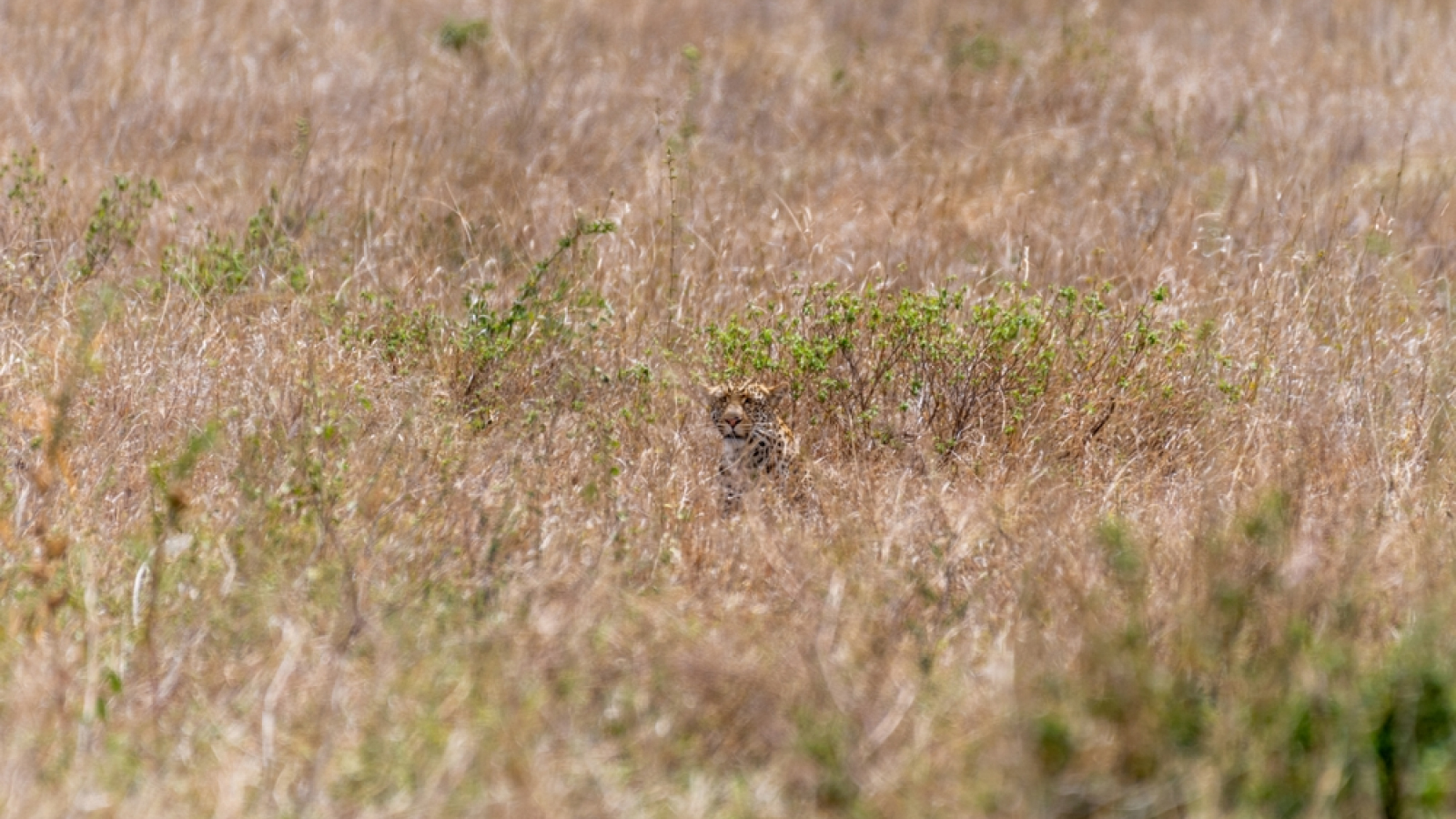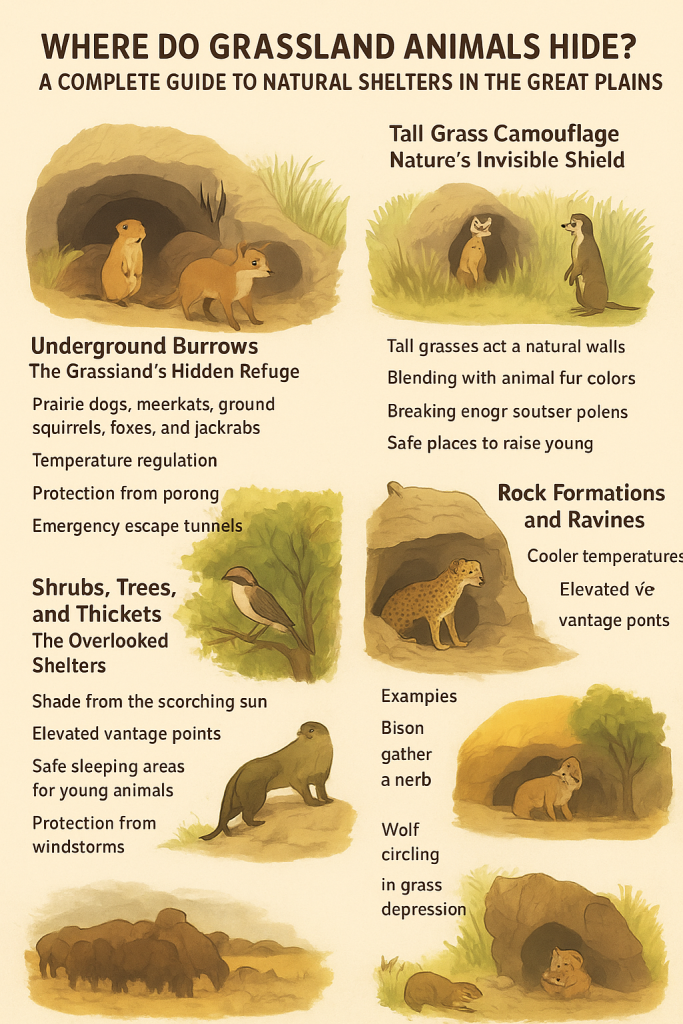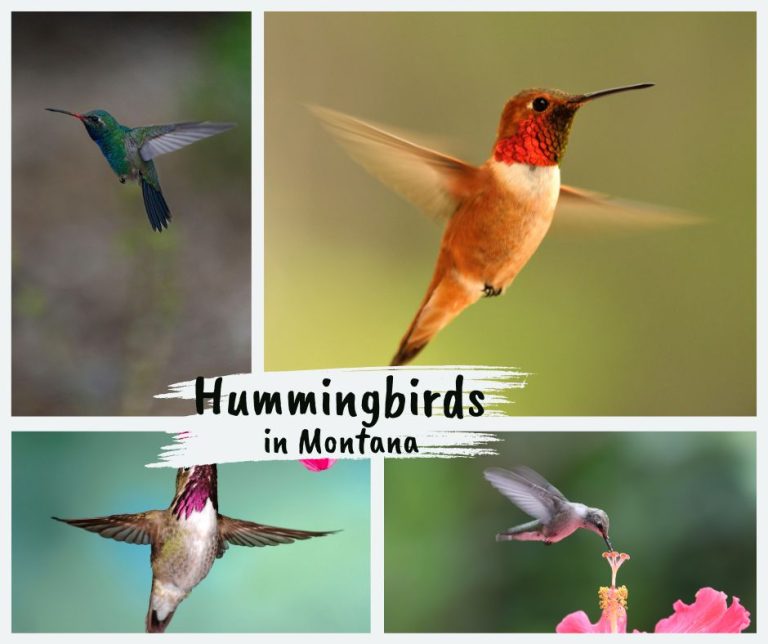Where Do Grassland Animals Hide?
Introduction
The Great Plains—and grasslands around the world—may look open and exposed, but to wildlife, this ecosystem is full of hidden shelters. From underground burrows to tall grass camouflage, grassland animals have evolved remarkable ways to stay safe from predators, survive harsh weather, and raise their young.
In this complete guide, we break down every major type of natural shelter used by grassland animals, how they’re built, and why they matter more than ever in today’s changing environment.
Grassland animal shelters
What Makes Grassland Habitats Unique?
Grasslands are dominated by tall grasses, scattered shrubs, and a wide, open horizon. Because trees and rocky areas are limited, animals must rely on other forms of shelter, often created by the landscape itself—or by the animals.
Key challenges of grasslands:
- Little natural cover → high visibility to predators
- Extreme temperature swings → hot days, cold nights
- Strong winds & seasonal fires
- Large predators like lions, cheetahs, wolves, or hyenas
1. Underground Burrows: The Grassland’s Hidden Refuge (Expanded)
Underground burrows are the most reliable and multifunctional shelters in the Great Plains. While grasslands seem exposed, the world beneath the surface is a complex network of tunnels that many species depend on for survival.
Animals That Build and Use Burrows (Expanded)
These underground architects include:
- Prairie dogs, the “engineers” of the plains with elaborate tunnel cities.
- Meerkats, who maintain shared burrow systems with lookout behavior.
- Ground squirrels, often using shallow burrows for quick escapes.
- Swift foxes and fennec foxes, which create dens to protect pups.
- Jackrabbits, known for combining shallow scrapes with deeper tunnels during winter.
Why Burrows Are Essential (Expanded)
Burrows provide multiple survival advantages:
- Temperature regulation: Underground temperatures remain stable year-round, sometimes up to 20°C (36°F) cooler during scorching summers and warmer in freezing winters.
- Predator avoidance: Many predators—like coyotes, lions, or hyenas—are too large to reach into complex tunnels.
- Raising young: Burrows provide isolated, quiet chambers where mothers care for their offspring.
- Longevity and reuse: Some burrow networks last for decades, being reused by different generations.
- Emergency escape tunnels: Multiple exits help prey evade predators using split-second decisions.
Interesting Ecological Fact (Expanded)
Prairie dog tunnel systems—sometimes called “towns”—can stretch for hundreds of acres. These burrows support entire ecosystems:
- Burrowing owls nest in abandoned holes.
- Snakes use tunnels to hunt small rodents.
- Insects and microorganisms thrive in the enriched soil.
These networks improve soil aeration, water absorption, and vegetation growth—making prairie dogs a keystone species.
2. Tall Grass Camouflage: Nature’s Invisible Shield (Expanded)
In the open landscapes of grasslands, tall grasses act as the first line of defense against predators. Though simple, this natural cover is one of the most effective shelters in the animal kingdom.
Animals That Rely on Grass Cover (Expanded)
- Gazelles and antelopes, whose tan coats match dry grass.
- Zebras, whose stripes disrupt visual tracking, especially for young calves.
- Ground-nesting birds, like quails and plovers, whose eggs are nearly invisible.
How Tall Grass Shelters Work (Expanded)
- Perfect camouflage: Colors and patterns blend with grass during daylight.
- Outline disruption: Predators spot shapes, not details → breaking the silhouette helps prey vanish.
- Stillness behavior: Animals stay motionless to avoid detection by movement-sensitive hunters.
- Wind barrier: For small animals, tall grass reduces wind impact and prevents overheating.
Special Behavior (Expanded)
Many antelope species use a “freeze-and-drop” technique:
- They instantly crouch into the grass.
- Lower their head and neck.
- Slow their breathing to minimize movement.
Even expert predators like lions or cheetahs can walk within meters without recognizing them.
3. Shrubs, Trees, and Thickets: The Overlooked Shelters (Expanded)
Though grasslands are not densely forested, scattered vegetation clusters act as essential hideouts and resting areas.
Used by Animals Such As (Expanded)
- Leopards, using trees for ambushes or dragging prey to avoid scavengers.
- Vervet monkeys, sleeping in high branches to avoid ground predators.
- Hyenas, resting under shrubs during daytime heat.
- Small birds, nesting in dense thickets for safety.
Benefits of These Shelters (Expanded)
- Shade and temperature control in regions that can exceed 40°C (104°F).
- Vantage points for predators and prey alike.
- Safe nurseries for raising young in more concealed areas.
- Storm protection, especially during heavy winds or dust storms.
Tree clusters often form “micro-habitats,” attracting insects, herbivores, carnivores, and even scavengers—creating a high-density hotspot in an otherwise open landscape.
4. Rock Formations and Ravines (Expanded
Areas where grasslands merge with rocky terrain provide unique shelter landscapes for many species.
Animals That Use Rocky Shelters (Expanded)
- Cheetahs, which climb rocks to scan for both prey and threats.
- Lions, using shaded crevices during the hottest hours.
- Hyraxes, naturally adapted to rocky outcrops.
- Small wild cats, hiding in cracks and narrow ravines.
Why These Shelters Matter (Expanded)
- Temperature moderation: Rocks absorb heat and release it slowly, creating cool/ warm zones.
- Physical barriers: Narrow crevices prevent large predators from entering.
- Escape paths: Elevated rocks give prey time to spot predators early.
- Protection from natural disasters: Ravines provide refuge during lightning storms or brushfires.
Rocky ravines often function as natural fortresses, creating miniature protected ecosystems.
5. Temporary Shelters: Seasonal and Weather-Based Protection (Expanded)
Temporary shelters emphasize behavioral survival strategies rather than physical structures.
Examples of Temporary Sheltering Behaviors (Expanded)
- Bison form tight herds, placing calves in the center during snowstorms or heavy winds.
- Elephants strategically position larger adults on the outer ring to shield smaller members.
- Birds take cover in shallow depressions, reducing exposure to heatwaves or predators.
- Wildebeests use herd movement to reduce risk while crossing open plains.
These short-term shelters become critical during storms, fires, migrations, droughts, or predator-intensive seasons.
6. How Predators Detect Hidden Prey (Expanded)
Predators have evolved sophisticated techniques to find prey, even when shelters are effective.
Common Predator Strategies (Expanded)
- Lions coordinate in groups to flush prey out of tall grass.
- Hyenas use acute smell to track hidden animals or detect burrow entrances.
- Wolves circle burrow openings and wait patiently for animals to emerge.
- Cheetahs rely on elevated rocks for scanning hundreds of meters across plains.
- Owls detect ground nesting birds using precise hearing at night.
This evolutionary arms race forces prey species to improve shelters, deepen burrows, enhance camouflage, and develop better group behaviors.
7. Why Grassland Shelters Are Disappearing (Expanded)
The loss of natural shelters is one of the biggest drivers of wildlife decline across global grasslands.
Main Causes (Expanded)
- Farming and agriculture: Land conversion destroys burrows, tall grasses, and soil structure.
- Overgrazing: Livestock reduces vegetation cover, leaving animals exposed.
- Urban expansion: Roads and cities cut through natural shelter zones.
- Wildfires: While some fires are natural, increased frequency destroys vital shelters.
- Climate change: Alters seasons, vegetation growth, and weather patterns—reducing shelter quality.
As shelter availability drops, animals become easier targets, migration routes break, and predator–prey dynamics destabilize—leading to ecosystem collapse.
8. How Conservation Efforts Protect Grassland Shelters (Expanded)
Modern conservation focuses not just on animals but on preserving the structures they depend on.
Methods Include (Expanded)
- Controlled burning: Eliminates old, dead vegetation and encourages new grass growth.
- Protecting burrow networks: Restricting agricultural equipment in key burrowing zones.
- Limiting land conversion: Creating legal protections for grassland reserves.
- Wildlife corridors: Allow animals to move safely between fragmented habitats.
- Community education: Teaching local communities about the ecological role of natural shelters.
- Monitoring programs: Scientists track burrow networks, predator–prey patterns, and shelter usage.
These strategies aim to maintain the long-term stability of grassland ecosystems.
Conclusion
Shelters are the hidden lifelines of the grassland world. From underground burrows to tall grasses, each plays a vital role in keeping wildlife alive in one of the most challenging ecosystems on Earth.
Understanding these shelters helps us appreciate wildlife survival—and reminds us why protecting grasslands is essential for the future.
❓ Frequently Asked Questions (FAQ)
1. What is the Great Grassland Wildlife Shelter?
The Great Grassland Wildlife Shelter is a protected sanctuary dedicated to rescuing, rehabilitating, and preserving wildlife native to grassland ecosystems. It provides a safe, natural environment for species such as antelopes, cheetahs, wild dogs, and various birds of prey.
2. What is the main purpose of this wildlife shelter?
The shelter focuses on:
- Protecting endangered species from poaching and habitat loss
- Rescuing and rehabilitating injured or orphaned animals
- Conducting biodiversity research
- Educating the public about wildlife conservation
3. Which animals are commonly found in grassland wildlife shelters?
Typical species include:
- Antelopes, wild horses, bison
- Cheetahs, lions, hyenas
- African wild dogs
- Eagles, vultures, prairie owls
4. Is the Great Grassland Wildlife Shelter open to visitors?
Many shelters allow visitors, but usually with limited access to avoid disturbing the animals. Some require advance booking or guided tours for safety and conservation reasons.
5. How can I support the Great Grassland Wildlife Shelter?
You can support by:
- Donating to conservation programs
- Volunteering for rescue or education activities
- Sponsoring an animal
- Raising awareness through social media or community outreach
6. Are the animals kept in captivity permanently?
Not always. Whenever possible, rehabilitated animals are released back into the wild. Only those unable to survive on their own stay under long-term care.
7. Are grassland shelters important for the ecosystem?
Yes. They help maintain biodiversity, protect threatened species, and serve as research hubs for understanding grassland ecology.








